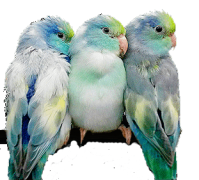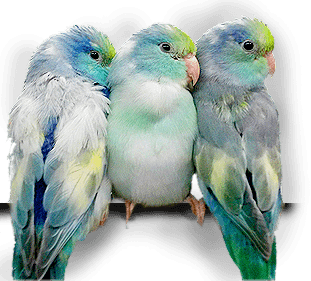
Early signs of illness in birds are often missed by the average pet owner. A sick bird will maintain their normal appearance as long as possible. One result of this behavior in companion birds is that by the time signs of illness are obvious, the bird may have been ill for some time. The bird that dies “suddenly” may only reflect the failure of the caretaker to identify the signs of illness. For this reason owners and caretakers should familiarize themselves with early signs of illness in pet birds so that any treatment or therapy and care by their Veterinarian will have a more favorable outcome.
Evaluation of Droppings
Droppings can be the indicator of your bird’s health. Paper towels, newspaper or other smooth substrates can be used to line the bottom of the cage so that the number, volume, color and consistency can be monitored. A bird’s normal droppings will vary in appearance depending on the bird’s diet.
Normal Droppings:
- Feces which is the food waste from the digestive tract can differ somewhat in color and consistency. Diets with a high seed content usually produce dark green feces. Birds on a formulated diet such as pellets will produce a soft brown feces.
- Urine is normally a clear liquid. A diet high in vegetables and fruits may increase the urine component.
- Urates which are the creamy white waste from the kidneys are often suspended in the liquid urine or appear to wrap around the feces.
Abnormal Droppings
Decrease in the total number or volume of droppings, color change of the urates/urine to green or yellow, Increased water content of the feces (diarrhea), Increased urine portion (Polyuria), Decrease in feces volume with increase in urates (polyurates), or presence of blood.
Some normal variations may be seen in impending egg-laying females or baby birds on hand-feeding formulas, the first void of the morning, conditions of nervousness and stress, or following a large meal of a specific colored food (ex. Blueberries). Owners and caretakers should evaluate several droppings under normal circumstances.
Early Signs of Disease
The following signs may not require emergency treatment but, because they are abnormal, any bird showing these signs should be seen by your veterinarian.
- Broken, bent, picked or chewed feathers
- Unusual dull feather color, or stained feathers around face and vent
- Crusty material in or around nostrils
- Redness, swelling or loss of feather around eyes
- Flakiness on skin or beak
- Baldness or sores on bottom of feet
- Lameness or shifting of body weight
- Overgrowth of beak or nails
- Minor changes in talking
- Biting or eating habits
- Low production in breeding birds.
Signs of Serious Illness
The following sign may indicate a serious health problem and immediate veterinary care should be given. This will include:
Significant changes in number and appearance of droppings (feces), Decreased or Excessive food or water consumption, Change in attitude, personality or behavior, Fluffed posture, Decreased vocalization, changes in breathing or abnormal respiratory sounds such as a clicking sound, changes in weight or general body conditions, Enlargement or swelling in the body, Any bleeding or injury, Vomiting or regurgitation, Discharge from nostrils, eyes, or mouth.
Emergency First Aid
Heat and food are the two most important considerations for temporary care of your sick bird until it can be seen by your veterinarian. The bird should be kept quiet and handling of the bird should be minimized. A temperature of 85°-90° should be maintained for injured or sick birds. Every effort must be made to encourage a sick bird to eat. Food should be placed where the bird is perched. Offer the bird’s favorite food by hand if necessary. An electrolyte solution, such as Pedialyte, may be given to help prevent dehydration. Do not administer liquid food if the bird is not swallowing. Always remember the smaller the bird, the more critical and prompt attention is needed.

